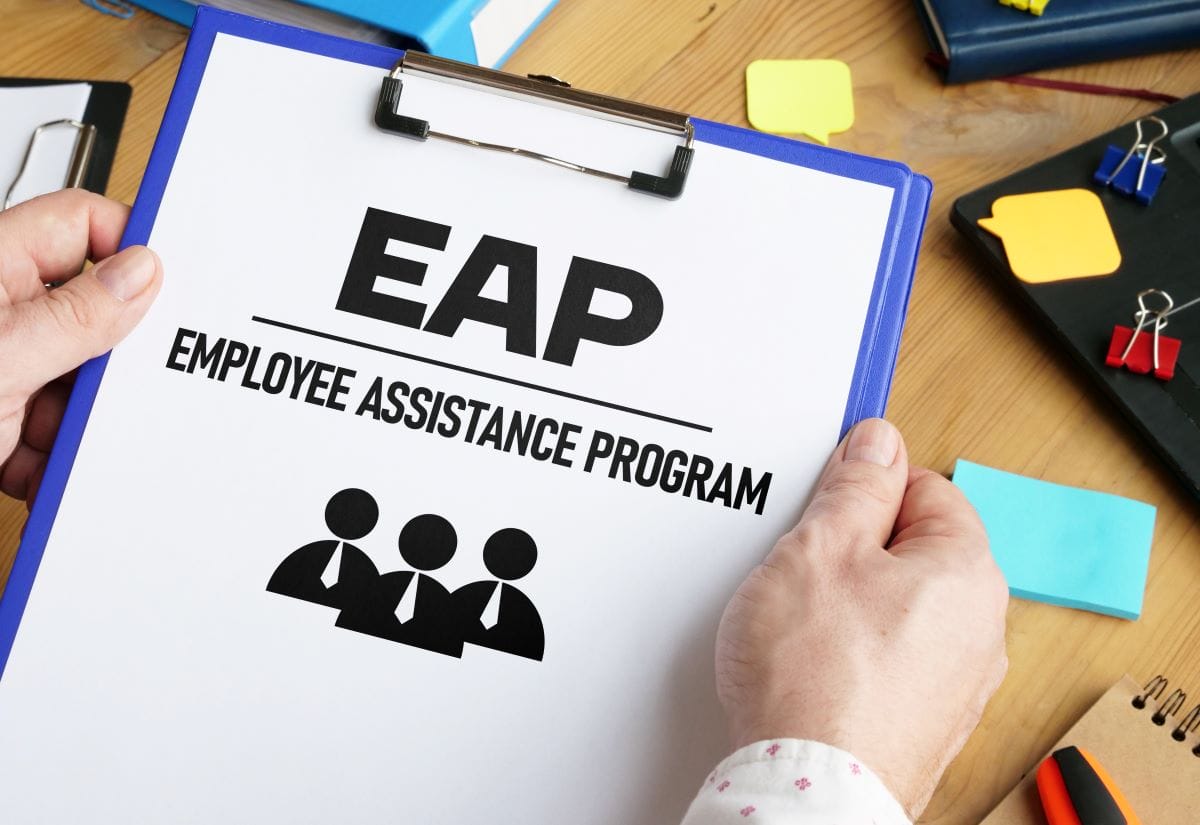Employee assistance programs (EAPs) help employees manage personal and work-related problems. This article will review the top seven EAPs and discuss their features and benefits for a healthier workplace.
Key Takeaways
Employee Assistance Programs (EAPs) provide confidential support to help employees manage personal and work-related challenges, impacting overall job performance and mental health.
Implementing EAPs leads to better workplace productivity, reduced employee turnover, and enhanced employee morale, benefiting both individuals and organizations.
When choosing an EAP, consider factors like specific organizational needs, cost, effective communication, and the provider’s range of services to ensure it meets employee requirements.
What is an Employee Assistance Program?

An Employee Assistance Program (EAP) is a voluntary, confidential workplace service designed to help employees deal with personal or work-related problems that might adversely impact their job performance, health, and well-being. These programs are provided by employers at no cost to employees and typically include services like assessments, short-term counseling, referrals, and follow-up services.
Goals of Employee Assistance Programs
The primary goal of an EAP is to assist employees in coping with various life stressors, which can range from substance abuse and stress management to grief, psychological disorders, and mental health concerns. Addressing these issues early helps maintain workplace mental health and prevents the decline in job performance due to unresolved personal problems.
Confidentiality is fundamental to EAPs, allowing employees to seek help without fear of repercussions. This legally protected privacy fosters trust and encourages service utilization. Overall, EAPs are a vital resource for promoting employee well-being and engagement.
Why Employee Assistance Programs are Essential

Employee Assistance Programs (EAPs) are essential because they provide critical mental health support and counseling services that help employees manage stress and emotional challenges. In a world where workplace pressures are constantly increasing, having access to such support can make a significant difference in an employee’s ability to cope with work-related stress and personal issues.
An EAP Program Benefits both Employees and the Employer
EAPs not only benefit the individual but also enhance overall workplace productivity. By addressing issues like absenteeism and presenteeism, EAPs help employees maintain focus and performance. This, in turn, leads to reduced costs associated with employee turnover and increased productivity. Organizations with EAPs often experience lower employee turnover rates because employees feel supported and valued, fostering a positive work environment that improves morale and workplace culture.
Offering an EAP enhances an organization’s brand as an employer. Potential talent is more likely to be attracted to companies that prioritize employee well-being and offer comprehensive support systems. EAPs also foster better communication and relationships between employees and management, contributing to a stronger, more cohesive workplace dynamic.
In summary, EAPs are a win-win for both employees and employers. They provide essential mental health support, improve productivity, reduce turnover, and enhance the overall workplace environment, making them an indispensable part of modern organizational strategies.
Key Features of Effective EAPs
An effective Employee Assistance Program (EAP) prioritizes confidentiality, allowing employees to seek help without fear of exposure. This builds trust and encourages more employees to utilize the services offered. Another critical feature is the availability of immediate counseling support through 24/7 clinical intake and crisis intervention services, which can be a lifeline in emergencies.
Flexibility in how care is delivered is also essential. Offering both virtual and in-person sessions makes it easier for employees to access the help they need, regardless of their location or schedule. Effective EAPs must also have robust communication strategies to boost awareness and encourage usage among employees.
Lastly, evaluating the full range of services is crucial. An effective EAP should go beyond just mental health counseling to include services like financial advice, legal consultations, and wellness programs. Thoroughly assessing organizational needs and selecting a provider with a comprehensive suite of services ensures the EAP will significantly impact employee well-being.
Confidentiality
Confidentiality is a cornerstone of any effective Employee Assistance Program (EAP). It ensures that employees can seek help for personal and work-related issues without fear of judgment or repercussions. This trust is vital for encouraging employees to utilize the services offered by EAP providers.
In the United States, the Employee Assistance Professionals Association (EAPA) sets stringent standards for EAP confidentiality. These guidelines include:
Protected Interactions: All interactions between employees and EAP counselors are confidential and protected by law. This legal protection ensures that employees can discuss sensitive issues openly.
Informed Consent: Before any information is shared with employers or other parties, employees must provide informed consent. This process ensures that employees are fully aware of and agree to any disclosures.
Limited Disclosure: Information is only disclosed to those who need to know, such as EAP counselors or supervisors, and only with the employee’s consent.
Secure Records: Accurate and secure records of employee interactions with EAP counselors are maintained to protect privacy and confidentiality.
By maintaining strict confidentiality, EAPs create a safe space for employees to address mental health issues, ultimately leading to improved well-being and productivity.
Accessibility and Outreach
Accessibility is a critical factor in the success of an Employee Assistance Program (EAP). To be effective, EAPs must be easily accessible to all employees, regardless of their location or work schedule. In addition, reminding employees of this important benefit is vital to sustain its use. Here are several ways to ensure that EAP services are readily available and ways to remind employees about your EAP:
24/7 Phone Support: Providing a toll-free phone number that employees can call at any time ensures that help is always available, even outside of regular working hours.
Online Portal: An online portal allows employees to access a wealth of EAP resources, including counseling services, health risk assessments, and stress management tools, from the comfort of their own homes.
Mobile App: A mobile app offers on-the-go access to EAP services, making it convenient for employees to seek help whenever and wherever they need it.
In-Person Sessions: Offering in-person counseling sessions at convenient locations, such as on-site at the workplace or at a nearby office, provides a personal touch and can be particularly beneficial for those who prefer face-to-face interactions.
Language Support: Providing EAP services in multiple languages ensures that a diverse workforce can access the help they need without language barriers.
- Posters, flyers, cards: Add posters to bulletin boards and update them with a new design and copy on a regular basis. Hand out flyers or cards noting important information about the program, especially ways to use it.
- Social media: Wherever your employees are looking online for company news is the place to add information about your EAP. Switch it up with different attention-getting headlines and include any changes in the program.
By making EAPs easily accessible, employers can encourage employees to seek help when they need it, leading to improved mental health and overall well-being.
Top 7 Employee Assistance Programs

Choosing the right Employee Assistance Program (EAP) can be a daunting task, given the plethora of options available. To assist in decision-making, we’ve compiled a list of the top seven EAP providers catering to various employee needs. These providers have been selected based on their comprehensive service offerings, innovative approaches, and proven effectiveness in enhancing workplace well-being.
Keep in mind that as an employer, you might decide to choose more than one EAP plan. Since they cover so many different areas, combining two plans that result in a better fit for your company could very well be the right solution.
From personalized mental health support to critical incident response, these EAPs cover a wide range of issues that employees might face. By investing in a robust EAP, organizations can ensure that their workforce remains healthy, engaged, and productive.
How we Chose the Top 7 EAP Providers
Finding an eap provider can be a substantial project for your HR department, in part because of the sheer number of providers all competing for your business. Doing a search on Google of the top EAP providers will give you supposedly unbiased sites listing their selection of top providers. However, most lists differ considerably from each other.
So we collected all the lists and all the providers. Each list that mentioned a provider received 1 vote. There were a total of 41 vendors on the list. Here’s the tally of the top 7 firms and the number of votes:
Lyra Health and Ulliance – Tied with 7 votes
BHS – 6 votes
CuraLinc, Magellan, and Modern Health – 5 votes
Spring Health – 4 votes
It was also important that certain criteria be met. The list needed to encompass EAP vendors that served both global, large enterprise, and small/medium sized businesses. Collectively, vendors needed to offer a variety of services including: employee wellness programs, a resource center portal, preventative care, health assessments, behavioral health, address substance abuse, life coaching, crisis management, a member assistance program, referral services, and more.
Next, we explore the specifics of each provider, highlighting their unique features and support types.
Modern Health
Modern Health stands out for its personalized approach to mental health support, addressing varying mental health needs by offering a blend of coaching, therapy, and community sessions that cater to individual employee requirements. One of the key features of Modern Health is its live group sessions, where employees can connect and share their experiences, fostering a sense of community and shared understanding.
The personalized treatment approach used by Modern Health ensures that each employee receives care tailored to their unique circumstances, rather than a one-size-fits-all model. This method is particularly effective in addressing varying levels of mental health challenges, categorized into red, orange, and green phases, ensuring targeted and appropriate support for all employees.
Modern Health’s comprehensive and personalized mental health care helps employees manage their mental health issues more effectively, contributing to improved workplace well-being, mental health services, prevention and health services, mental health benefits, and productivity.
Spring Health
Spring Health’s Employee Assistance Program is renowned for its wide range of support services, including self-help resources, coaching, therapy, and rehabilitation. Employees benefit from the first 10 therapy sessions being free, with subsequent sessions covered by insurance, making mental health care more accessible.
Utilizing Precision Mental Healthcare technology, Spring Health personalizes mental health support through machine learning, ensuring employees receive the most effective care tailored to their needs. Additional resources such as Care Navigators, utilization reports, and wellness programs further enhance the support provided.
Spring Health also offers critical incident support, both virtually and on-site, providing flexible solutions for employers to manage workplace crises effectively. This approach ensures employees have the resources needed to maintain their mental and physical health and well-being.
Lyra Health
Lyra Health is distinguished by its integration of evidence-based techniques in providing mental healthcare solutions. The focus on evidence-based treatments ensures that employees receive the most effective and scientifically validated care available.
Customized care plans, self-care resources, coaching, therapy, and progress assessments make up the comprehensive services offered by Lyra Health. The high recovery rate of 83% among its members is a testament to the effectiveness of its approach.
Lyra Health’s services can seamlessly integrate with existing health plans, offering a smooth and cohesive experience for both employees and employers. This commitment to providing proven treatments and connecting employees with top-tier mental health providers ensures high-quality care and support.
Ulliance
Ulliance offers a comprehensive Employee Assistance Program designed to resolve personal concerns, workplace conflicts, and life challenges. Employees have unlimited access to self-care resources, workshops, videos, mental health tips, flexible counseling, behavioral coaching, discounted financial/legal consultations, and free HR consultations.
In the event of traumatic incidents such as death, accidents, or robbery, Ulliance provides unlimited critical incident support, ensuring that employees receive the necessary assistance during crises. With 30 years of experience and a 94% success rate in helping participants overcome their problems, Ulliance is a trusted provider of EAP services.
This extensive support system not only helps employees manage their personal and professional challenges but also contributes to a healthier and more resilient workforce.
Magellan Healthcare
Magellan Healthcare’s EAP focuses on addressing member engagement and psychosocial needs, providing affordable and timely access to care. The program covers a wide range of personal challenges, including legal and financial support, ensuring comprehensive assistance for employees.
With a 93% client retention rate, Magellan Healthcare demonstrates a high level of client satisfaction and trust. Additionally, half of Magellan Healthcare’s staff hold clinical qualifications, ensuring that employees receive care from highly trained professionals.
This focus on quality and accessibility makes Magellan Healthcare a reliable choice for organizations looking to support their employees’ mental and emotional well-being.
CuraLinc Healthcare
CuraLinc Healthcare combines technology with personalized advocacy to deliver efficient and effective mental health support. The integration of technology in their framework allows for more streamlined and accessible care. Personalized advocacy ensures that employees receive tailored support, resulting in more meaningful and impactful assistance.
This innovative approach promotes better mental health outcomes by merging cutting-edge technology with personalized care. This combination enhances mental health support, helping CuraLinc Healthcare improve employee well-being and workplace productivity.
BHS
BHS specializes in enhancing performance and reducing health insurance costs through its comprehensive Employee Assistance Programs. The focus on assistance, care, and behavioral health services ensures that employees receive the support they need to thrive.
BHS offers a range of services, including counseling, usage analytics, personalized care, and unlimited phone sessions, providing flexible and accessible support for employees. Both face-to-face sessions and unlimited phone sessions are available, catering to different preferences and needs.
With a dedicated case manager for each case, BHS ensures personalized and continuous care, enhancing the effectiveness of their EAP services.
How to Choose the Right EAP for Your Organization
Choosing the right Employee Assistance Program (EAP) involves considering several key factors. Start by assessing the specific needs and objectives of your organization and employees. This will help in selecting an EAP that aligns with your goals and provides the necessary support.
Cost is another crucial factor. While budget constraints are important, it’s essential to remember that lower-cost EAP options may not offer the level of service required. It’s often true that you get what you pay for, so investing in a quality EAP can yield significant returns in terms of employee well-being and productivity.
Effective communication is vital for enhancing employee engagement with the EAP. Use materials that are easily accessible and ensure that employees are aware of the benefits and services available. Supervisor support is also critical, so providing adequate training for supervisors can help in the successful implementation of the EAP.
Prepare Lists
Once you have your criteria, it’s important to create a list of vendors that meet your criteria. Much can be found online, but it is very important to contact the provider directly to verify that what they offer will meet your company’s needs.
Having a list of relevant use cases and questions is critical before attending demos for potential EAP providers. This will ensure that you gather all the necessary information to make an informed decision. Carefully considering these factors allows you to choose an EAP that best meets the diverse needs of your organization and its employees.
Benefits of Implementing an EAP

Implementing an Employee Assistance Program (EAP) offers numerous benefits for both employees and employers. These programs provide a range of support services, including short-term counseling, referrals, and follow-up for employees facing personal or occupational challenges.
Employee Mental Health
One of the most significant benefits is the enhancement of employee mental health and well-being. EAPs address various issues impacting mental and emotional health, such as substance abuse and stress, leading to improved individual well-being and job performance. This, in turn, enhances employee engagement and productivity, as employees are more likely to be focused and motivated when they feel supported.
Employee Retention, Lower Absenteeism, Improved Safety
Additionally, EAPs can result in substantial cost savings for employers by reducing the frequency of claims related to health and safety issues. They also contribute to employee retention by improving job satisfaction and engagement, which is vital for minimizing replacement costs. Overall, the implementation of an EAP can create a healthier, more supportive, and productive workplace.
Common Challenges in EAP Implementation
Implementing an Employee Assistance Program (EAP) is not without its challenges.
Proving ROI
One of the primary difficulties is proving the return on investment (ROI) for EAPs, which can complicate funding decisions and hinder widespread adoption. Organizations often struggle to quantify the direct financial benefits of EAPs, even though the positive impact on employee well-being and productivity is evident.
Developing the Internal Policy
Another common challenge is the development of an effective internal policy for the EAP. This includes clearly outlining access procedures, addressing privacy concerns, and providing comprehensive information about the program and its benefits. Without a well-defined policy, employees may be hesitant to utilize the services, fearing breaches of confidentiality.
Opting for a third-party service provider is usually recommended over creating an in-house program. Third-party providers bring expertise and a range of services that might be challenging for an organization to replicate internally. However, after selecting an EAP provider, it’s crucial to publicize the program and policy effectively, ensuring that all employees are aware of the services available and how to access them.
Pricing and ROI of EAPs
The cost of implementing an Employee Assistance Program (EAP) can vary widely depending on the provider, the size of the organization, and the level of service required. Here are some common pricing models:
Per-Employee-Per-Month (PEPM) Model: This model charges a fixed fee per employee per month, regardless of usage. It provides predictable costs and is easy to budget for.
Per-Use Model: This model charges a fee each time an employee uses the EAP service. It can be cost-effective for organizations with lower utilization rates.
Tiered Pricing Model: This model offers different levels of service at varying price points, allowing employers to choose the level of service that best fits their needs and budget.
While the cost of an EAP may seem like an added expense, the return on investment (ROI) can be significant. According to the Department of Labor, employers can save an average of $5 to $16 for every dollar invested in an effective EAP. This is because EAPs can help reduce absenteeism, turnover, and healthcare costs, while also improving employee productivity and job satisfaction.
Some common benefits of EAPs that contribute to a positive ROI include:
Reduced Absenteeism and Turnover: By addressing personal and work-related issues, EAPs help employees stay focused and engaged, reducing the likelihood of absenteeism and turnover.
Improved Productivity and Job Satisfaction: Employees who feel supported are more likely to be productive and satisfied with their jobs.
Reduced Healthcare Costs: EAPs can help employees manage stress and other mental health issues, leading to fewer healthcare claims and lower costs.
Enhanced Employer Reputation: Offering an EAP demonstrates a commitment to employee well-being, making the organization more attractive to potential talent.
By investing in an EAP, employers can create a positive work environment that supports the mental health and productivity of their employees.
Measuring the Success of Your EAP

Measuring the success of an Employee Assistance Program (EAP) is crucial for ongoing improvement and demonstrating its value to the organization.
Measure Employee Utilization Rates
One way to gauge success is by evaluating the percentage of employees using EAP services, which can indicate the program’s visibility and acceptance among the workforce. High utilization rates often reflect a well-publicized and trusted program.
Conduct Surveys
Employee satisfaction with EAP services can be assessed through surveys and feedback, providing insights into the perceived value and effectiveness of the program. Positive feedback and high satisfaction rates suggest that the EAP is meeting employees’ needs and helping them cope with personal and professional challenges.
Analyze Case Resolution Rates
Regular evaluation of the program’s effectiveness through utilization and outcome data is essential. This includes analyzing case resolution rates and the overall impact on employee well-being and productivity. Regular surveys and data collection enable organizations to make informed decisions about necessary EAP adjustments and enhancements.
Employee Assistance Program System Demo Questions
When evaluating an Employee Assistance Program (EAP) system, it’s essential to ask the right questions during the demo to ensure that the system meets your organization’s needs. Here are some key questions to consider:
Scope of Services: What is the range of services offered by the EAP system? Does it include counseling, health risk assessments, stress management tools, and other support services? Some companies include sexual harrassment or other types of training in their EAPs, so think about this one to ensure you’ve included what will benefit your company and its workforce.
Confidentiality and Security: How does the system ensure the confidentiality and security of employee data? What measures are in place to protect privacy?
Access Process: What is the process for employees to access EAP services? How are they supported throughout the process?
Reporting and Analytics: Can the system provide customized reporting and analytics to help track employee engagement and outcomes?
Integration: How does the system integrate with existing HR systems and benefits? Is it compatible with other tools and platforms used by the organization?
Cost and Fees: What is the cost of the system? Are there any additional fees for implementation or ongoing support?
Training and Support: What kind of training and support is provided to the HR team and employees to ensure successful implementation and utilization of the system?
Crisis Management: How does the system handle crisis situations, such as employee suicidal ideation or substance abuse? What protocols are in place?
Mental Health Resources: Does the system provide access to mental health resources and counseling services for employees and their families?
Employee Satisfaction: How does the system measure employee satisfaction and engagement with the EAP services?
By asking these questions, you can gain a comprehensive understanding of the EAP system’s features, functionality, and benefits, helping you make an informed decision about whether it’s the right fit for your organization.
Summary
Employee Assistance Programs (EAPs) are invaluable tools for promoting workplace well-being and supporting employees through personal and professional challenges. By offering confidential counseling, assessments, and a range of support services, EAPs help employees manage stress, improve mental health, and maintain productivity.
The benefits of implementing an EAP are extensive, including enhanced employee engagement, reduced absenteeism, and lower turnover rates. Effective EAPs prioritize confidentiality, offer flexible care options, and provide comprehensive support that goes beyond mental health counseling. Choosing the right EAP involves careful consideration of organizational needs, costs, and the quality of services provided.
In conclusion, EAPs are essential for fostering a supportive and productive workplace environment. By investing in a robust EAP, organizations not only enhance employee well-being but also improve their overall performance and attractiveness as employers. Don’t wait—start exploring the best EAP options for your organization today and take the first step towards a healthier, happier workforce.


